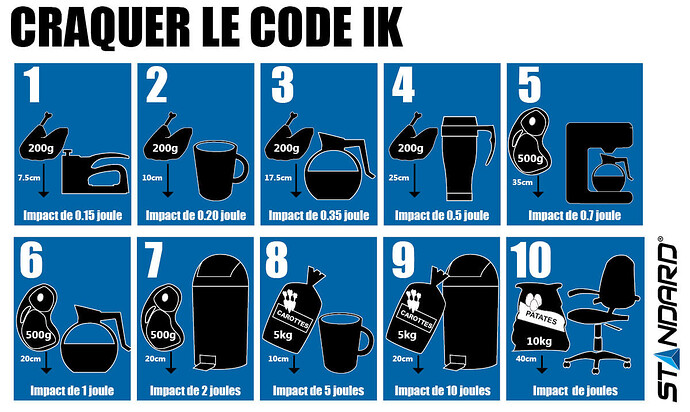Hello hello.
Another beta question and unrelated to CAD (although)
In my company, we carry out IK tests. So, I can tell you how many Joules you need depending on the desired index.
Nevertheless, how do you translate all this into "daily life"?
Because to explain to trainees and/or people who are not mechanics, it's still easier to say that IK2 is like a punch while IK11 is a train launched at full speed (fanciful example and surely false)
While searching for what these tests are, I found this page: IK Index.
At the bottom, there is a small table with an equivalence but it may not be concrete enough.
3 Likes
Hello
If you take the type of material
1°) an electrical cabinet assembled and furnished on site with a static fixing (installed or screwed and which will never move from this location) an index of IK one for the whole is sufficient.
2°) this same cabinet is mounted on a construction machine (typically a backhoe) which undergoes shocks and rotational accelerations, then the index must be higher and takes into account the total weight.
3°) still this cabinet but used as a low voltage cabinet on a site that will be loaded and unloaded from trucks without too much care so you have to consider a fall of 1 to 2 meters.
ETC Hypothesis = mass / height = a two-hundred-kilogram cabinet that falls two meters, the fixings of the components must resist even if the cabinet is totally dented (VS smashed)
Kind regards
2 Likes
@stefbeno
I think that's the right answer.
The table gives the link between the mass and the height of the fall.
So an IK10 index means that you can withstand 3 shocks with a mass of 25kg falling from 800mm (25kgx10x0.8m = 200J (there are still small roundings in the table on the g to 10 instead of 9.8)).
Not much more to add.
2 Likes
Yes, no, but that's ok 
It's just that I don't find it very telling for the uninitiated.
I had found an image that goes a little in the direction of what I want. But I still find it too unclear
1 Like
Hello @coin37coin
There are two things, it seems to me, the impact illustrated in the table and the synoptic diagram of carrots and potatoes.
Once you know that, you need to know if:
1°) You want to know the impact on the ground and the deformation of it under the impact.
2°) or the result on the object that fell
The impact force in a shock will depend on the deformation of your object.
That's why I took the case of things that fall from the truck (a well-known phenomenon in the suburbs).
In fact, everything depends on the way in which the kinetic energy will dissipate in the object, which conditions the time for the deceleration and the form of the deceleration, knowing that it will not be constant.
In other words, knowing the impact in joules of a 1 m high hardened steel cube is good, but the question is why do it.
The deformation of the ground, the deformation of the object or both.
In reality, it seems to me that the problem is more that of a drop test!
https://help.solidworks.com/2018/french/SolidWorks/cworks/c_Drop_Test_Studies
https://www.metropack.fr/tests-de-transport/contraintes-de-manutention
In other words, it's not because someone hits me one joule that I'm going to stretch the second 
Kind regards
1 Like
